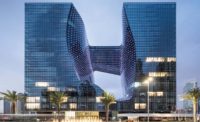Burj Dubai Breaks Record... and Keeps Going
The Burj Dubai realized its “tallest high-rise building in the world” claim on July 21, according to developer Emaar Properties, when the concrete floors were poured and set on the skyscraper’s 141st story. At 1,680 feet tall, the still-incomplete tower surpassed the previous height record of 1671 feet, established by Taiwan’s Taipei 101, and surges toward an undisclosed height rumored to be 2,300 feet, some 160 stories, when the tower is finished in 2008.

The Burj Dubai, in the United Arab Emirates, reached a milestone on Saturday when construction workers poured concrete for the 141st floor--making this 1,680-foot-tall skyscraper the tallest building in the world.

Photo: Courtesy Emaar Properties
Although developer Emaar Properties and architects at Skidmore Owings & Merrill are keeping the Burj's final height a secret, the 160-story building could reach 2,300 feet by the time it is finished in 2008.
Designed by a team of 90 architects at Skidmore Owings & Merrill, and erected by a small army of 6,800 laborers in grueling desert temperatures reaching 120 degrees Fahrenheit, the Burj Dubai achieved its height record just 1,276 days after construction began. Its composite concrete and rebar floors are rising at an average rate of three days per level. But aside from the speed of construction and the building’s sheer size, the Burj is “epoch defining” for typifying the “supertall” typology, says Carol Willis, director of The Skyscraper Museum in New York City. Supertall is a category of buildings that soar past 1,250 feet or 80 stories tall.
“What we’re seeing in these supertall buildings is a shift in construction type,” says Willis, whose museum is featuring a show about the Burj through September. “In the 20th century, the paradigm was an office building built of steel in North America. Now it’s mixed-use, and principally residential, built of concrete or composite, and primarily in the Middle East or Asia. It’s become essentially the opposite.”
The Burj’s highest 50 floors will contain office space, while the remaining interior program is devoted to a luxury hotel, on floors one through 20, and penthouse apartments, on floors 20 through 110. Its floor plates will taper from 33,607 square feet, at the base, to 10,788 square feet at the top—half the size of floor plates in the 108-story Sears Tower, which contains nearly the same cubic volume as the Burj. Residential towers require less floor plate area, Willis explains, because they contain fewer elevators than office skyscrapers.
The $1.4 billion Burj tower is the focal point of Emaar’s Downtown Burj Dubai, a 500-acre, $20 billion development where the operative word appears to be “big.” The complex will feature the world’s largest entertainment center and shopping mall—totaling 12 million square feet—an artificial lagoon, and additional residential high-rises. Apartments with Burj tower views, Willis says, are already commanding higher prices than those featuring only desert views.
“When these buildings are really built in the real world they certainly stand for a kind of visionary ambition, but that doesn’t exclude a rational blueprint for their economic viability,” she says. “As long as there are people that want to live or work with that elevated status or perspective, these buildings will continue to rise into the sky.”



